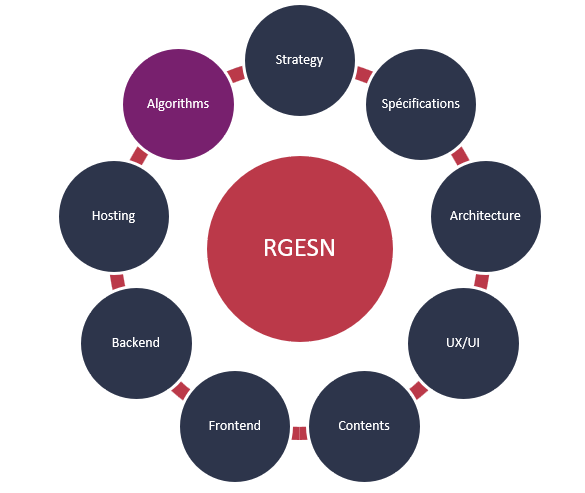2 weeks ago, we published an article presenting the RGESN and eco-design. In the meantime, a new version of the RGESN has been published… and it has brought a number of changes that we felt were important to present.
A new topic: Algorithms
This is the most visible new feature!
The RGEN has no longer 8 topics but 9:

This topic, even if its name doesn’t give it away, focuses exclusively on AI and the model training phase.
This is a choice that we have observed, but which does not necessarily convince us, because we think it is a shame to have an eco-design topic that is exclusively linked to one technology and more specifically to one aspect of the technology. We hope that future versions will include criteria relating to algorithms, even outside AI, because we know that different algorithms do not consume the same resources to achieve the same result.
A notion of priority within the criteria
This is probably the most important and structuring change in the new RGESN. In the previous version (the one still online at the time of publication of this article), each of the 79 criteria was equally important. This made it possible to calculate coverage fairly simply but, in our view, did not provide a clear indication of what needed to be put in place as a priority. This is no longer the case with this new version!
Each criterion has a 2 parameters :
- An implementation difficulty
- An implementation priority
Has the digital service been favorably evaluated in terms of utility, considering its environmental impact?

Priority can obviously be debated just as much as difficulty, but this separation gives interesting indications in terms of prioritisation for any organisation wishing to reduce the environmental footprint of its Digital Services.
What’s more, these 2 concepts also make it possible to implement ‘easy’ actions first in order to highlight successes and get the ball rolling.
Similarly, the notion of priority makes it possible to implement interesting coverage, as is the case for the WCAG standard with the A, AA and AAA criteria. Before this version of the RGESN, we had a coverage of X%, but this same coverage can now say that we cover 100% or 25% of the priority criteria.
A reorganisation of criteria
The number of criteria has been reduced from 79 to 78 with the addition of a new topic. There has therefore been real work done on the organisation of the criteria, with:
- The deletion of some criteria
This is often due to simplification. For example, there is the:
« Does the digital service provide audio content with a level of compression appropriate to the content and the listening context? »
which has been removed. It existed for video and audio and has been retained only for video, which has a much greater environmental impact.
- Merging certain criteria
Some criteria were linked or quite similar. The new version has decided to merge them, as is the case with the new criterion:
« Does the digital service set retention periods for data and documents so that they can be deleted or archived once this period has elapsed? »
which merges the criterion of the definition of retention periods and the effective deletion of data.
- Reformulating criteria
This reformulation is fairly frequent and is generally intended to make the criterion easier to understand or to avoid using an arbitrary indicator in the terminology of the criterion. This is the case for:
«Can the digital service be used on older models of terminal? »
In the case of the example above, this choice also has its limits, as the criterion becomes ‘fuzzier’. We now need to ask the question ‘What is an old terminal model? ’.
- Change of criteria category
This is also quite common for a repository that has already been established. We have identified 5 criteria, most of which have been moved from the strategy topic to the specifications topic.
This can be seen in particular with the criterion on the age of terminals, which has also been reformulated.
- The creation of new criteria
With a new topic, it couldn’t be any other way. Numerous criteria have been created, many of which focus on specific technologies such as AI and blockchain. Beyond these techno-centric criteria, there are also some very interesting new criteria that are linked to user usage. I’m thinking in particular of this criterion:
« Does the digital service provide a ‘listen only’ mode for its videos? »
This criterion is based on the widespread practice of listening to videos (e.g. many people use YouTube to listen to music). In this case, the video image is useless and there is no need to load the image.
Conclusion
The new version of the RGESN, while retaining the same basic principles as its predecessor, provides a number of structural changes.
Some of these are a step in the right direction, such as indicating priorities, while others leave us more sceptical… And that’s normal!
The real interest lies in the fact that it is a living reference framework, which will continue to evolve and which will, I hope, enable us to provide digital services of a more sustainable quality.



